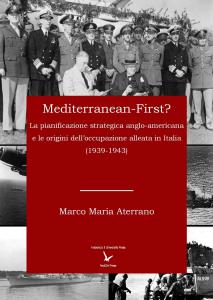
Mediterranean-First?: La pianificazione strategica anglo-americana e le origini dell’occupazione alleata in Italia (1939-1943) by Marco Maria Aterrano
 World War II was the most significant European and global conflict of the twentieth century – historically, politically, ideologically – a conflict, whose cultural legacy still greatly affects international relations on the world arena today and reminds us about le passé qui ne passe pas. War pages of history are comprised of complex and controversial narratives of perpetrators and victims: those who later became celebrated, glorified, forever commemorated; or those who become feared, loathed, pitied, or forever forgotten. At the same time, with all due respect to the arguably immune factuality of history as it should be, as wisely pointed out by Koselleck (2004), “we still lack a history of a formula historia magistra vitae”(24). Winners write history as we know it today from national Grand Master Narratives (Winter, 2016), often resulting in what Nietzsche once defined as “the use and abuse of history,” for the sake of fitting certain national agendas, and reconfirm ideological status quo, as demonstrated by countless traditional understandings of the origins, the proceedings, and the outcomes of the World War II.
World War II was the most significant European and global conflict of the twentieth century – historically, politically, ideologically – a conflict, whose cultural legacy still greatly affects international relations on the world arena today and reminds us about le passé qui ne passe pas. War pages of history are comprised of complex and controversial narratives of perpetrators and victims: those who later became celebrated, glorified, forever commemorated; or those who become feared, loathed, pitied, or forever forgotten. At the same time, with all due respect to the arguably immune factuality of history as it should be, as wisely pointed out by Koselleck (2004), “we still lack a history of a formula historia magistra vitae”(24). Winners write history as we know it today from national Grand Master Narratives (Winter, 2016), often resulting in what Nietzsche once defined as “the use and abuse of history,” for the sake of fitting certain national agendas, and reconfirm ideological status quo, as demonstrated by countless traditional understandings of the origins, the proceedings, and the outcomes of the World War II.
Complex relations between Germany, France, and Great Britain, and – eventually – the Superpowers of the Soviet Union and the United States – have been traditional scholarly foci of the European and world historians till recently. A new book by Marco Maria Aterrano, Mediterranean-First?: La pianificazione strategica anglo-americana e le origini dell’occupazione alleata in Italia(1939-1943)/ Strategic Anglo-American planning and the origins of the Allied occupation in Italy (1939-1943)[i] adds a salient dimension to the existing scholarly debate by focusing on the significantly understudied area of the conflict – the Mediterranean, and, more specifically, Italy. Aterrano challenges the traditional interpretation of the Mediterranean as the arena of a marginal war and the common approach of the Allied forces to destroy Nazi Germany (the famous Germany-first approach). Instead, he suggests that the Allied planning for the re-conquest of Europe and, particularly, the Mediterranean, inevitably manifested in the form of the elimination of Italy in the initial stages of the global conflict, thus making Europe-first quasi-synonymous with Italy-first. Aterrano’s book carefully revisits the (pre-) and the actual war pages of the European and world history, pays greater attention to regional historicism of the Mediterranean, and elaborates on the complexities of how the concept of Italy-first to a certain (undermined and understudied) degree determined the eventual outcomes of WWII.
Mediterranean-First? is a historically profound, culturally sound, and politically complex study of various dimensions of WWII in Europe. The book consists of three major parts, preceded by a thought-provoking introduction and followed by a tantalizing conclusion. The first part focuses on the British strategy for Italy in years 1939-1941, starting with the detailed explanation of Italian non-belligerency, continuing with the Italian (historically inevitable) intervention, and the consequent strategic deadlock of 1941. The scholar analyzes Italy’s predictable intervention alongside Nazi Germany, the expected rapid deterioration of Anglo-Italian relations (especially in face of triple threat, represented by Germany, Italy, and Japan), and refers to Churchill’s famous exclamation about the Mediterranean being England’s first battlefield in the War. Particularly interesting are Aterrano’s elaboration of the initial potentiality of Italian neutrality in the War, combined with the interpersonal factors of political world leadership of the time – i.e., Churchill’s long and sincere admiration for Mussolini (31), combined with Roosevelt’s urgent invitation of the Italian Dictator to participate in the peace conference, meant to discuss the future of Europe (38). The pages describing Mussolini’s enthusiasm about euphoric victories of the Wehrmacht throughout Europe, and the consequent communication between Mussolini and Hitler, invite the reader to recall Leni Riefenstahl’s epic documentaries dedicated to the Führer, and eventually understand – from the point of view of international relations and global conflict – the Italian point of no return. And, to draw the inevitable parallels between Mussolini’s appearance on the balcony of Palazzo Venezia versus Hitler’s appearance as the omnipotent Führer on the Nuremberg balcony in Triumph of the Will. The third chapter, under the self-explanatory title of the strategic deadlock elaborates on a long and exhausting series of defeats of the Italian forces in multiple Mediterranean locations – ranging from the Greek mountains, the Ionian waters, to deserts of North Africa, as salient for setting the stage for the British conceptualization of Italy as the weak link of the Axis and further development of the warfare in the Mediterranean. It also provides evidence for potentiality of a peaceful resolution between Rome and London, and explains why that potentiality was never realized: Referring to the indissoluble nature of complex relationship between Mussolini and Hitler, the book portrays Italy as Odysseus in the ocean of international politics, forced to navigate between Scylla and Charybdis, and eventually choosing its German ally as what looked like the lesser evil. The climax of the first part is reached through the introduction of the so-called “game-changer” – Hitler’s infamous Operation Barbarossa and the invasion of the Soviet Union regardless of the previously signed Nichtangriffspakt with Joseph Stalin. The German attack on the USSR – the latter defining the aggression as nothing less than the Great Patriotic War – was, in its turn, the German point of no return and clearly marked the beginning of the end.
The second part of Aterrano’s book focuses on the combined planning of the Allies in the Mediterranean, revisiting Arcadia and the beginning of the Atlantic collaboration, continuing with the comprehensive study of competitive cooperation and Allied arrival in the Mediterranean, and ending with “the birth” of the Mediterranean strategy and the reappearance of Italy. This part of the book guides the reader through the historic pages of the War with the special emphasis on the American development in the region, and the complexity of Anglo-American relationships, combined with a detailed analysis of Roosevelt’s view of the War, the consequential policies, decision making, and strategic military interventions. Since the War – with the exception of the Japanese attack on Pearl Harbor – was primarily fought on the European territory and was initially interpreted as the European conflict before it became the global one, Aterrano wisely analyzes the reasons of the American initial and later altered motivation to even participate in the conflict. In line with Frank Capra’s famous propaganda film Why We Fight that served as a strategic successful response to Riefenstahl’s Triumph of the Will and appealed to the ultra-American values of freedom from the slavery from the fascist world, the scholar explains the unique nature of American motivation of the WWII intervention and, more specifically, the US strategy for the Mediterranean region. Particularly captivating are the pages dedicated to the Atlantic Conference, and the main results, achieved by Anglo-American leaders. Notably, Aterrano clearly distinguishes between the strategic and ideological levels of the British versus US involvement, and demonstrates how the inflexible American Weltanschauung led to their emergent and growing dominance on the world arena. Possibility of the Pacific approach as a result of Pearl Harbor, the questionable salience of Germany-first, the potentiality of Europe-first, and the joint forces of the Allies against the European powers of the Axis, autumn 1942 as a turning point of the War, as well as the growing roles of Washington and Moscow (aka the military Superpowers) in the conflict constitute the captivating topicality of the second part of the book. Similar to Finkielkraut’s provocative reflection of the history of humanism and the relationship of this historical traditional to the rise of totalitarianism in In the Name of Humanity, Aterrano reminds the reader that the twentieth century has staged a war for the domination of the world in the name of ideological and philosophical principles. This part of the book also prepares the reader for the dramatic outcomes regarding Italy on the bloody arena of the world politics: at that point of history, the inevitable strategic attack against Italy meant desired withdrawal of fascist forces from the Balkans and from the Soviet front, forcing the Germans to replace those same forces with new divisions and thus weakening their grip (139). In other words, attacking Italy and the Mediterranean in general would be nothing less than a strategic military handicap for Germany.
The third and final part of the book centers Italy as the second front of the theatre of war. It starts with analyzing dramatic international developments in various locations around the globe, ranging from Casablanca to Trident (The Third Washington Conference), elaborates on strategic choices of localities for Allies’ attacks (such as Sicily), extends to the Mediterranean diatribes, provides a unique insight into the genesis of the administration of the Allies forces, and provides a powerful and sobering closure: for Italy, for the Mediterranean, and for the War dynamics as it used to be. Aterrano addresses some dramatic tropes, used by the participant of the War actions to refer to the Mediterranean as a mystical and terrifying dark hole (152), of type “abandon all hope, all who enter here,” comparable to the affect of Joseph Conrad’s Heart of Darkness. A solid part of the book is dedicated to the international relations, questions of political seniority in Europe and on the world arena at large, arguable diplomacy, debates, power games, as well as the administrative and ideological agendas of those involved in the theatre of war. The most dramatic part focuses on the beginning of the irreversible course of war in Sicily. Aterrano revisits historic particularities of Italian struggles on the European arena, combined with the Italian internal political crisis, and invites the reader for a critical reconsideration of the roles played by the Allies in creating drastic circumstances in Italy that would lead to the actual “morte della patria” (death of the Fatherland) and the disappearance of Italy as a unitary state (216). The scholar asks a sobering question: “Was that necessary?” Especially taking into consideration the fact that the inter-allied debates on the fate of the campaign in the Mediterranean continued even after the fall of the fascist regime and the consequent military defeat of Italy. Eventually, the historic narrative transcends to the transcultural level of global conflict and elaborates on the fast-developing shifts in power, especially with respect to not only the Western powers but also the “red dragon” of the Soviet Red Army. The concluding chapter of the book explains the complexity of American growing supremacy and its effects for inter-Allied relations, restates the idea of elimination of Italy in the context of European campaign in the “genuinely Anglo-American theatre” of the Mediterranean, and sheds more light on the tormented sea of the international relations among the World Powers, whose legacy, alarmingly enough, are as salient on the world arena today as they were in the last century. And, thinking about the fate of Italy in WWII, the reader can’t help thinking about Stig Dagerman’s (2018) heartfelt statement from German Autumn: “deserved suffering is no less difficult to bear than the undeserved one” (151).
The legacy of World War II – the questions of culpability, victimage, suffering, coming to terms with the past, but also the ethics of and the “ownership” of cultural memory, as well as the politics of representation or historic amnesia – still divide the world today. The history – especially in the form of Grand Master Narratives – is typically written by the winners. The Americans and the post-Soviets claim their victory in WWII, so do the British or the French, while all the infamous pages of history – ranging from the French strategic omission of the Vichy regime to the Soviet occupation of multiple countries of the former Soviet Bloc, to the Anglo-American occupation of Italy – naturally fall into oblivion. In that regard, Marco Maria Aterrano provides a very rich and nouvelle perspective on the theatre of war, European history, and the politics of memory. In addition to Aterrano’s focus of the European history per se, the international and intercultural appeals of the book make it particularly fascinating, and invitational of potential further research. Since Italy and Germany were going through similar stages of regime, yet fascism showed different faces in Italy and Germany, strongly affected by the personality cults of the Duce and the Führer; bringing up comparative insights on the two fascist regimes and the two fascist leaders could provide a more holistic understanding of what Italy’s positionality and decision making looked like all the way throughout the conflict. Where does WWII legacy leave Italy today, torn between culpability, victimage, and unresolved questions of War ethics, and how do those phenomena compare to German Vergangenheitsbewältigung? On a related note of the challenge of nations coping with their turbulent pasts, and given today’s war-torn realities of the former post-Soviet terrains, it is also advisable to resist the geo-politically and culturally problematic “default trend” of making the usage the “Soviet” and the “Russian” interchangeable. Suffice it to say that the USSR consisted of fifteen republics, and WWII broke out on the Lithuanian, Belarusian and Ukrainian fronts long before it reached actual Russia.
Overall, Mediterranean-First? offers an intellectually stimulating, rigorously analyzed, eloquently and elegantly written, and historically well-informed study of WWII in Italy, Europe, and the world at large, written by a brilliant scholar, concerned with contemporary history and with an acute understanding of national regionalism. In addition to the realm of world history, it engages a great variety of disciplines without yet compromising on the original aims and scope of the book and provides a valuable perspective for Italian and generally European studies, philosophical, political, and critical cultural fields; it could greatly benefit scholars of global conflict, identity, and cultural memory, as well as ethnographers, sociologists, anthropologists, and critical cultural scholars.
Reviewed by Julia Khrebtan-Hörhager, Colorado State University
Mediterranean-First?: La pianificazione strategica anglo-americana e le origini dell’occupazione alleata in Italia (1939-1943)
By Marco Maria Aterrano
Publisher: Federico II University Press
Hardcover / 285 pages / 2017
ISBN: 978-88-6887-012-6
To read more book reviews click here.
Published on October 2, 2018.
References:
Conrad, J. (1996). Heart of Darkness. New York, NY: Palgrave Macmillan.
Dagerman, S. (2018). Autunno Tedesco. Milan, Italy: Iperborea.
Finkielkraut, A. (2000). In the Name of Humanity: Reflections on the Twentieth Century. New York, NY: Columbia University Press.
Koselleck, R. (2004). Futures Past: On the Semantics of Historical Time. New York, NY: Columbia University Press.
Nietzsche, F. W. (2006). The Use and Abuse of History. New York, NY: Cosimo, Inc.
Winter, J. M. (2006). Remembering War: The Great War between Memory and History in the Twentieth Century. New Haven, CT: Yale University Press.
[i] Translation from Italian by the author.




